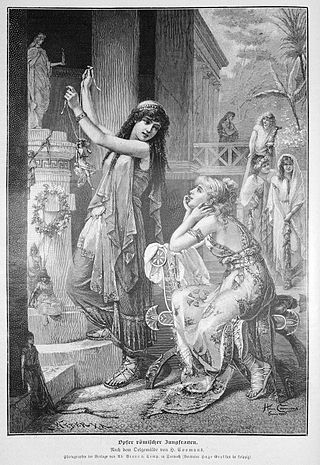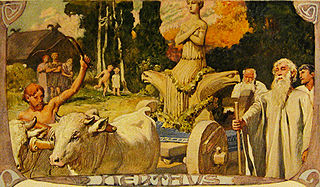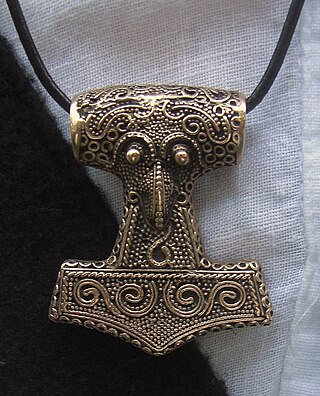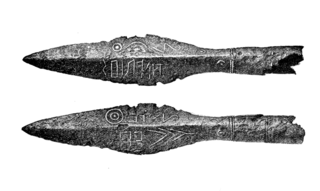External links
-
 Media related to Germanic religion at Wikimedia Commons
Media related to Germanic religion at Wikimedia Commons
Germanic religion may refer to:
Heathenry is a modern Pagan new religious movement that has been active in the United States since at least the early 1970s. Although the term "Heathenry" is often employed to cover the entire religious movement, different Heathen groups within the United States often prefer the term "Ásatrú" or "Odinism" as self-designations.

Modern paganism, also known as contemporary paganism and neopaganism, is a term for a religion or a family of religions which is influenced by the various historical pre-Christian beliefs of pre-modern peoples in Europe and adjacent areas of North Africa and the Near East. Although they share similarities, contemporary pagan movements are diverse and as a result, they do not share a single set of beliefs, practices, or texts. Scholars of religion often characterise these traditions as new religious movements. Some academics who study the phenomenon treat it as a movement that is divided into different religions while others characterize it as a single religion of which different pagan faiths are denominations.
Norse is a demonym for Norsemen, a Medieval North Germanic ethnolinguistic group ancestral to modern Scandinavians, defined as speakers of Old Norse from about the 9th to the 13th centuries.

Paganism is a term first used in the fourth century by early Christians for people in the Roman Empire who practiced polytheism, or ethnic religions other than Judaism. In the time of the Roman Empire, individuals fell into the pagan class either because they were increasingly rural and provincial relative to the Christian population, or because they were not milites Christi. Alternative terms used in Christian texts were hellene, gentile, and heathen. Ritual sacrifice was an integral part of ancient Graeco-Roman religion and was regarded as an indication of whether a person was pagan or Christian. Paganism has broadly connoted the "religion of the peasantry".
Germanic may refer to:

Germanic mythology consists of the body of myths native to the Germanic peoples, including Norse mythology, Anglo-Saxon mythology, and Continental Germanic mythology. It was a key element of Germanic paganism.

Old Norse religion, also known as Norse paganism, is a branch of Germanic religion which developed during the Proto-Norse period, when the North Germanic peoples separated into a distinct branch of the Germanic peoples. It was replaced by Christianity and forgotten during the Christianisation of Scandinavia. Scholars reconstruct aspects of North Germanic Religion by historical linguistics, archaeology, toponymy, and records left by North Germanic peoples, such as runic inscriptions in the Younger Futhark, a distinctly North Germanic extension of the runic alphabet. Numerous Old Norse works dated to the 13th-century record Norse mythology, a component of North Germanic religion.

Germanic paganism or Germanic religion refers to the traditional, culturally significant religion of the Germanic peoples. With a chronological range of at least one thousand years in an area covering Scandinavia, the British Isles, modern Germany, and at times other parts of Europe, the beliefs and practices of Germanic paganism varied. Scholars typically assume some degree of continuity between Roman-era beliefs and those found in Norse paganism, as well as between Germanic religion and reconstructed Indo-European religion and post-conversion folklore, though the precise degree and details of this continuity are subjects of debate. Germanic religion was influenced by neighboring cultures, including that of the Celts, the Romans, and, later, by the Christian religion. Very few sources exist that were written by pagan adherents themselves; instead, most were written by outsiders and can thus present problems for reconstructing authentic Germanic beliefs and practices.

Heathenry, also termed Heathenism, contemporary Germanic Paganism, or Germanic Neopaganism, is a modern Pagan religion. Scholars of religious studies classify it as a new religious movement. Developed in Europe during the early 20th century, its practitioners model it on the pre-Christian religions adhered to by the Germanic peoples of the Iron Age and Early Middle Ages. In an attempt to reconstruct these past belief systems, Heathenry uses surviving historical, archaeological, and folkloric evidence as a basis, although approaches to this material vary considerably.

Anglo-Saxon paganism, sometimes termed Anglo-Saxon heathenism, Anglo-Saxon pre-Christian religion, or Anglo-Saxon traditional religion, refers to the religious beliefs and practices followed by the Anglo-Saxons between the 5th and 8th centuries AD, during the initial period of Early Medieval England. A variant of Germanic paganism found across much of north-western Europe, it encompassed a heterogeneous variety of beliefs and cultic practices, with much regional variation.

Polytheistic reconstructionism is an approach to modern paganism first emerging in the late 1960s to early 1970s, which gathered momentum starting in the 1990s. Reconstructionism attempts to re-establish genuine polytheistic religions in the modern world through a rediscovery of the rituals, practices and contextual worldviews of pre-Christian pagan religions. This method stands in contrast with other neopagan syncretic movements like Wicca, and ecstatic/esoteric movements like Germanic mysticism or Theosophy.
Continental Germanic mythology formed an element within Germanic paganism as practiced in parts of Central Europe occupied by Germanic peoples up to and including the 6th to 8th centuries. Traces of some of the myths lived on in legends and in the Middle High German epics of the Middle Ages. Echoes of the stories, with the sacred elements largely removed, may appear throughout European folklore and in European fairy tales.
Gothic Christianity refers to the Christian religion of the Goths and sometimes the Gepids, Vandals, and Burgundians, who may have used the translation of the Bible into the Gothic language and shared common doctrines and practices.
Persecution of Germanic Pagans may refer to:
The pagan religion of the Germanic tribal confederation of the Franks has been traced from its roots in polytheistic Germanic paganism through to the incorporation of Greco-Roman components in the Early Middle Ages. This religion flourished among the Franks until the conversion of the Merovingian king Clovis I to Nicene Christianity, though there were many Frankish Christians before that. After Clovis I, Frankish paganism was gradually replaced by the process of Christianisation, but there were still pagans in the late 7th century.
Modern paganism in the United States is represented by widely different movements and organizations. The largest modern pagan religious movement is Wicca, followed by Neodruidism. Both of these religions or spiritual paths were introduced during the 1950s and 1960s from Great Britain. Germanic Neopaganism and Kemetism appeared in the US in the early 1970s. Hellenic Neopaganism appeared in the 1990s.
European religion may refer to:

The Verein für germanisches Heidentum, abbreviated VfGH, is a Germanic neopagan organisation in Germany. It began in 1994 as the German chapter of the British Odinic Rite and was called the Odinic Rite Deutschland. It became independent in 2004 and changed its name in 2006. Though it has never had many members, it is nonetheless influential among German neopagans. Prominent people within the organisation have included Bernd Hicker, who was its first leader, and Fritz Steinbock, who has managed and influenced its religious practice.

Gothic paganism was the original religion of the Goths before their conversion to Christianity.

Trees hold a particular role in Germanic paganism and Germanic mythology, both as individuals and in groups. The central role of trees in Germanic religion is noted in the earliest written reports about the Germanic peoples, with the Roman historian Tacitus stating that Germanic cult practices took place exclusively in groves rather than temples. Scholars consider that reverence for and rites performed at individual trees are derived from the mythological role of the world tree, Yggdrasil; onomastic and some historical evidence also connects individual deities to both groves and individual trees. After Christianisation, trees continue to play a significant role in the folk beliefs of the Germanic peoples.